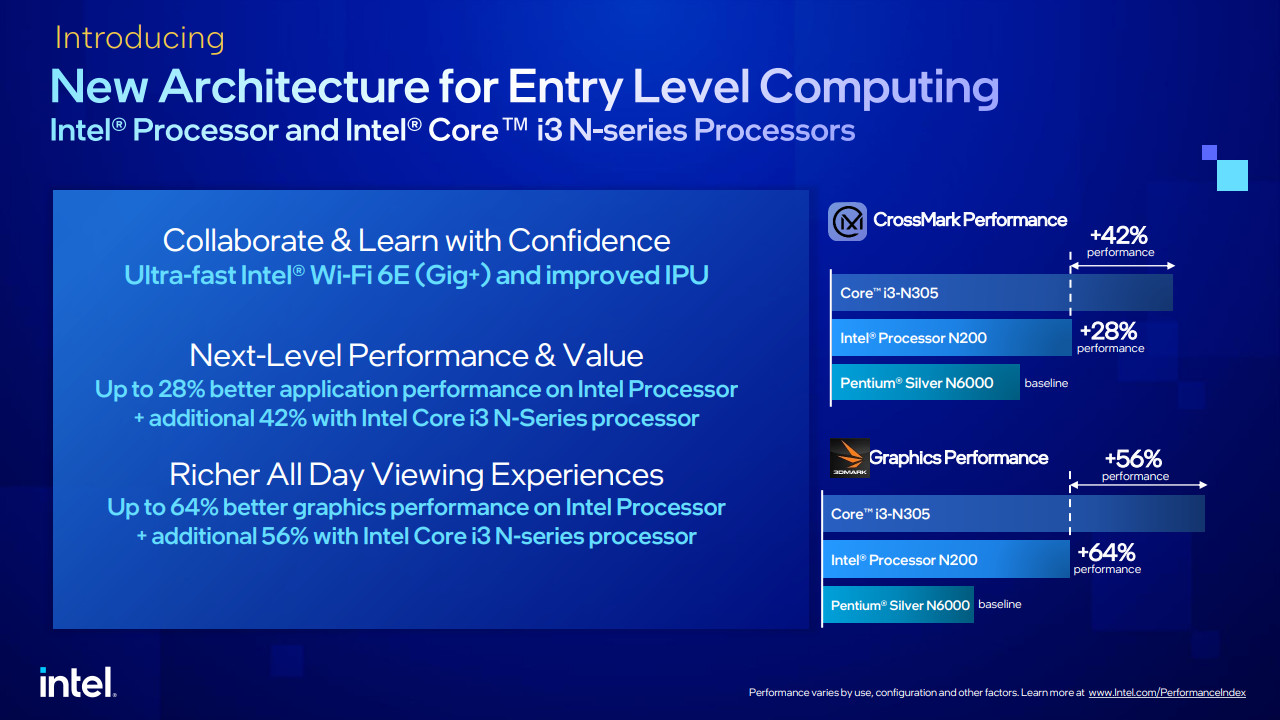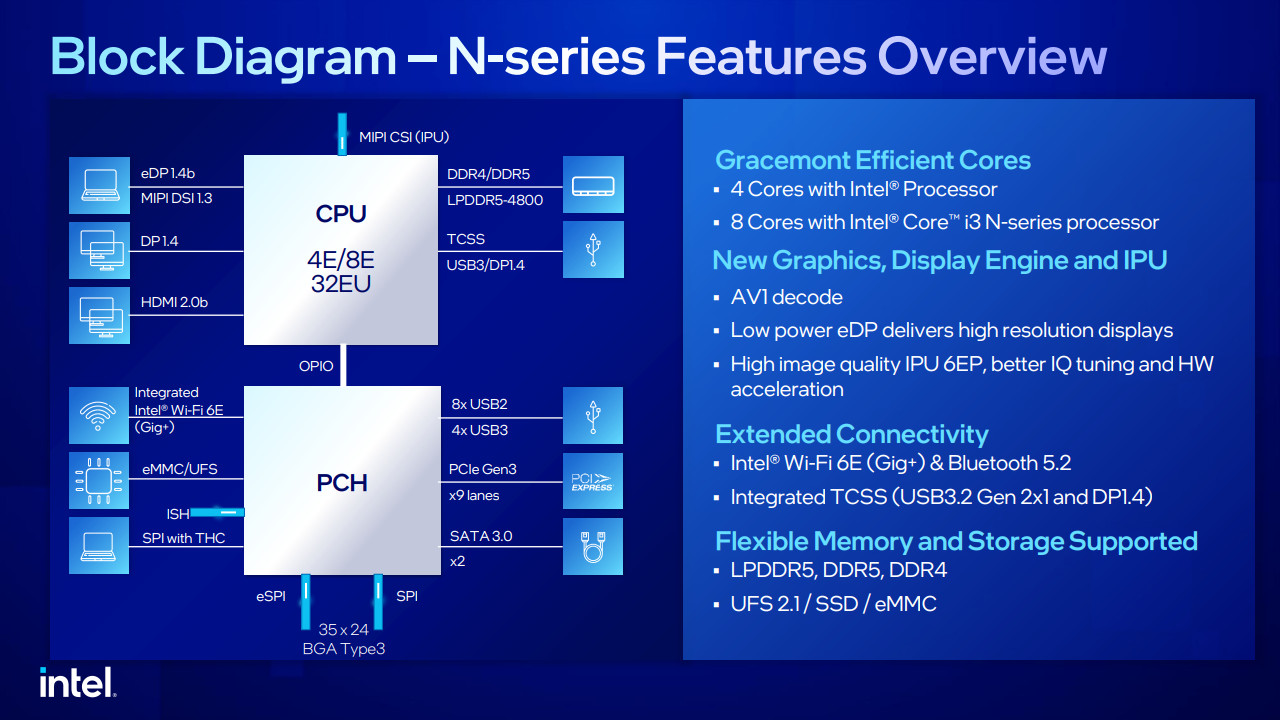What you need to know
- Intel unveils new entry-level CPUs at CES 2023 in Las Vegas, including high-performance i3 Core processors.
- The Gracemount CPUs divide into two categories, with low-power Intel Processor N100 and N200 chips alongside higher-wattage Core i3-N-300 and N-305 variants.
- The new chips support DDR4, DDR5, and energy-efficient LPDDR5 memory modules for extended battery life.
- Targeting the education sector, these mobile processors offer low price points for high-performance productivity machines running Windows or ChromeOS.
Intel unveils its latest line of entry-level processors at CES 2023 in Las Vegas, the N-Series, to replace the Pentium and Celeron branding. These CPUs have been specifically designed with the education sector in mind to create affordable laptops in schools, alongside other scenarios requiring low-power computers with support for IoT (Internet of things) edge native applications.
The N-Series chips offer up to 8 efficient cores built on Intel 7 process tech and feature improved graphics capabilities without affecting laptop battery life, making them well-suited to help students and teachers immerse themselves in the classroom or elsewhere. Improvements included with Intel’s IPU 6 (image processing unit) support higher-resolution webcams with post-processing effects, such as noise suppression, at a lower cost to improve the videoconferencing experience.

In addition to their focus on energy efficiency, Intel’s new N-Series processors also support modern Wi-Fi 6E (Gig+) wireless networking for more reliable connections on devices in the classroom and at home, with up to 3x faster speeds than Wi-Fi 5. Divided into two categories, the Intel Processor and Core i3 range of N-Series chips feature across-the-board improvements over their previous-generation counterparts.
With their new Gracemont microarchitecture, these low-power CPUs allow Intel to offer raised standards for collaborative learning with fantastic value for money. Revealing specifications for all four processor variants, the affordable Intel Processor N100 and N200 chips can clock up to 3.7GHz boost frequency while using only 6W power. Scaling up to the i3 Core N-Series requires more power, up to 15W for the i3-N-305 chip, but all variants include support for modern DDR5 or low-power LPDDR5 RAM, plus previous-generation DDR4 memory support.
| Header Cell – Column 0 | Intel Processor N100 | Intel Processor N200 |
|---|---|---|
| Max turbo frequency | Up to 3.4GHz | Up to 3.7GHz |
| Cores/threads | 4/4 | 4/4 |
| L3 cache | 6 MB | 6 MB |
| Memory channels | 1 | 1 |
| Memory type | LPDDR5 4800 MT/s | LPDDR5 4800 MT/s |
| Row 5 – Cell 0 | DDR5 4800 MT/s | DDR5 4800 MT/s |
| Row 6 – Cell 0 | DDR4 3200 MT/s | DDR4 3200 MT/s |
| Graphics frequency | Up to 750 MHz | Up to 750 MHz |
| Graphics chip | Intel UHD | Intel UHD |
| Execution units | 24 | 32 |
| Max turbo power | 6 W | 6 W |
| Header Cell – Column 0 | Intel Core i3-N300 | Intel Core i3-N305 |
|---|---|---|
| Max turbo frequency | Up to 3.8GHz | Up to 3.8GHz |
| Cores/threads | 8/8 | 8/8 |
| L3 cache | 6 MB | 6 MB |
| Memory channels | 1 | 1 |
| Memory type | LPDDR5 4800 MT/s | LPDDR5 4800 MT/s |
| Row 5 – Cell 0 | DDR5 4800 MT/s | DDR5 4800 MT/s |
| Row 6 – Cell 0 | DDR4 3200 MT/s | DDR4 3200 MT/s |
| Graphics frequency | Up to 1.25 GHz | Up to 1.25 GHz |
| Graphics chip | Intel UHD | Intel UHD |
| Execution units | 32 | 32 |
| Max turbo power | 15 W | 7 W |
Choosing the highest-model Core i3 N-Series chip allows up to 42% overall performance improvements for general application use and up to 24% faster web browsing, perfect for remote learning. HDMI 2.0b support, alongside DisplayPort 1.4, allows 4K videos with HDR over up to 3 simultaneous displays, with 10-bit HEVC and VP9 encoding/decoding and AV1 decoding for higher color depth. Intel claims HD video presentations can last up to 10 hours before needing to recharge a laptop battery.

Over 50 OEM model designs featuring the N-Series CPUs from manufacturers, including Acer, ASUS, Dell, HP, and Lenovo, are expected to launch within 2023 on mobile machines running Windows and ChromeOS. Supporting affordable storage, such as eMMC solid-state drives, alongside memory offering lower power draw or cheaper prices in the previous DDR4 generation means the N-Series chips should enjoy a long-lasting footprint in the entry-level PC category.
Windows Central take
Maximum energy efficiency is critical when targeting the education sector since you can’t expect a class full of students to be permanently hard-wired into AC power. The modern teaching environment has extended into a hybrid of at-home and collaborative conferencing scenarios, so any boost to battery life and wireless networking will help tremendously with video presentations and remote work. Expanding to Core i3 chips is an exciting prospect for the entry-level Intel category, but time will tell if 15W on the N305 is low enough to provide the promised all-day power.




